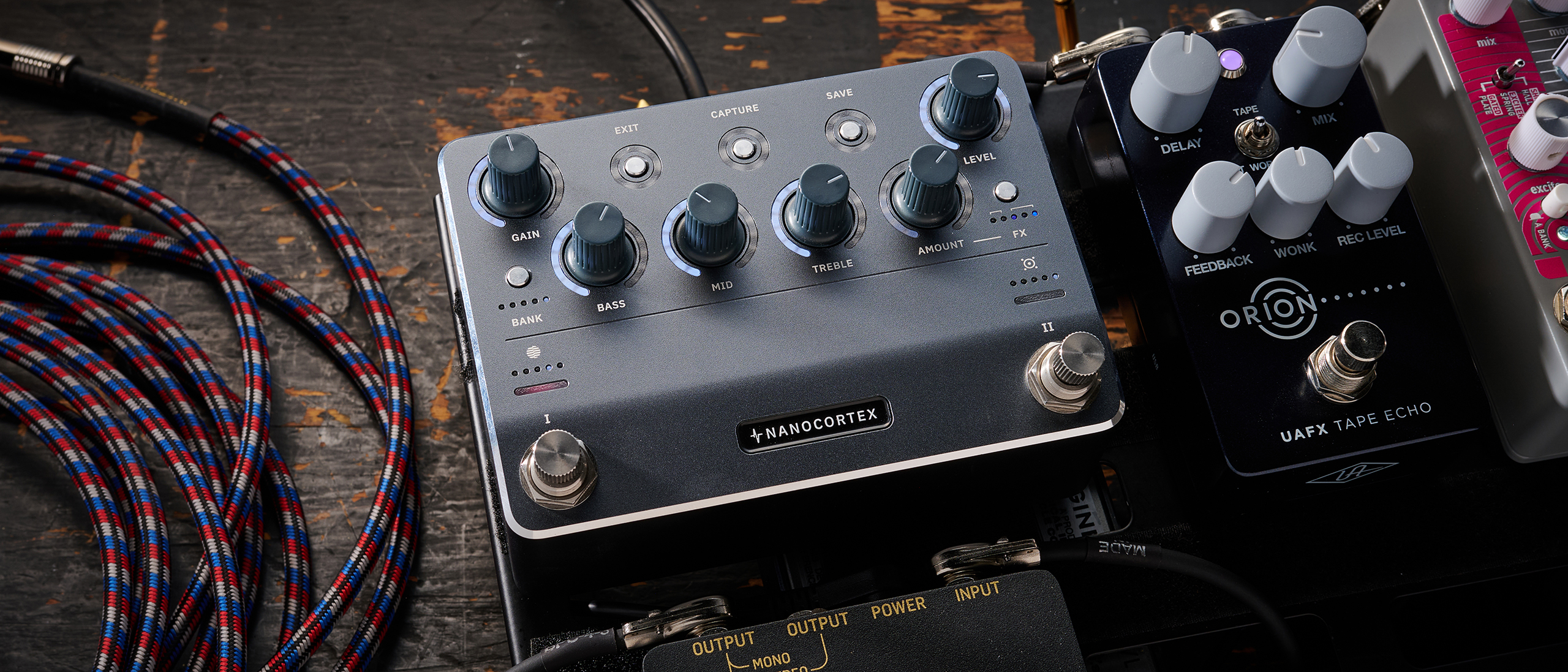MusicRadar Verdict
The Nano Cortex is the best all-in-one capture device for value, portability and usability right now. The latest 2.0 firmware update has expanded its multi-effects versatility significantly and Neural DSP has opened up its technology to more players here, delivering a versatile and compact pedal capable of delivering great sounds in different scenarios.
Pros
- +
Excellent sounds for guitar and bass.
- +
Intuitive controls with smooth app integration.
- +
A well-built self-contained capturing device.
- +
Versatile tool for practice, recording and live.
- +
First major firmware update has added 40 new effects – including drives, making it more versatile.
- +
USB-C power option makes it even more portable.
Cons
- -
Some players will prefer the deeper control of modelling.
- -
No XLR out, stereo input.
- -
More Neural-generated amp and pedal captures would be nice.
MusicRadar's got your back
What is it?
Specs impress, features can wow us on paper and screen with guitar gear, but they don't actually count for a whole lot if a product isn't user-friendly and usable in a way that doesn't just make it a worthwhile purchase, but one that actually enhances our experience as guitarists. It is a tall order, but when a company gets it right it's a wonderful thing.
So it proved with Neural DSP's Quad Cortex. I remember the buzz spreading through the NAMM 2020 show. We didn't know it was coming but the company hadn't just rolled up to the grand annual MI industry gathering with its first hardware, it was an amp and effects modeller and capture device with a touch screen. A touch screen! Established names in the game hadn't even reached that point yet and Neural had only been in business for three years at that point. But the signs had been there.
Its plugins up to that point and co-founder Doug Castro's work with Darkglass Electronics suggested it had an impressive background, but surely it couldn't deliver on all that promise in its hardware debut?
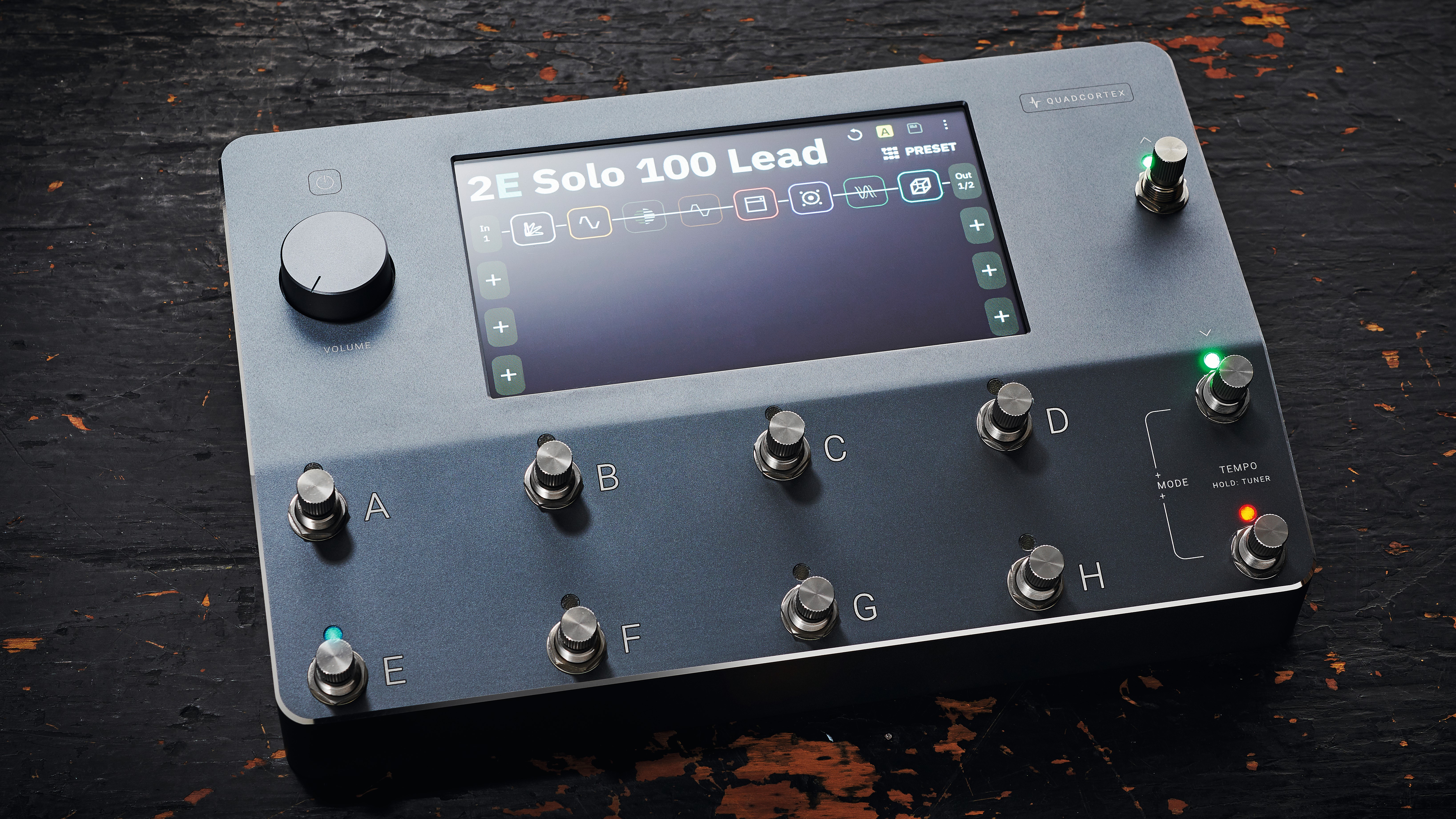
"The NAMM show back then was a very difficult time, because it was a very early prototype where we had to orchestrate the moves of everything – every single block in the grid – to make it work with what we had back then," Castro's Neural DSP co-founder Fancisco Cresp tells us. "But we just knew we could do it."
Neural DSP has done it – the Quad Cortex is up there as one of the very best amp modellers and multi-effects processors available, used by pros around the world. But the journey is never over for this kind of company – well over four years on and Neural DSP is still working hard to deliver on the plugin compatibility for the QC it promised early, and it's now being rolled out to an enthusiastic user base.
The QC's CorOS firmware updates so far underline a commitment to constant improvement. "It's the most intense years of my life, for sure," admits Francisco. "I'm just happy that people like it, and that people are using our products live and in the studios. And then you listen to a record that you like and find out, oh, they use our stuff – that's awesome!"
Indeed, but what's next?
Want all the hottest music and gear news, reviews, deals, features and more, direct to your inbox? Sign up here.
From talking to Francisco, accessibility is clearly a priority for the company. The Quad Cortex's $1,699 price is not accessible to most of us though. It wasn't a reach to expect the second Neural DSP hardware release to be more affordable, but expecting it to be Neural's answer to Helix's HX Stomp for the price we see here probably was.
Instead, the company has honed in on the capture side of the Quad for the Nano Cortex – compact pedal-based unit that will fit in on your existing pedalboard and desk. There's no screen – LEDs, mini buttons and six knobs, two rotary footswitches are tasked with control, alongside the Cortex smartphone app. It comes installed with 25 guitar and bass amp profiles curated by Neural, eight guitaf and two bass cab IRs and five effects drawn from the Quad Cortex. There's also something that its closest competition doesn't offer right now; it can capture amps and effects without any external devices or software.
But before we go any further, it's important to define the difference between modelling and capturing (Kemper calls its own approach to the latter 'profiling'). So I asked Francisco himself to explain.
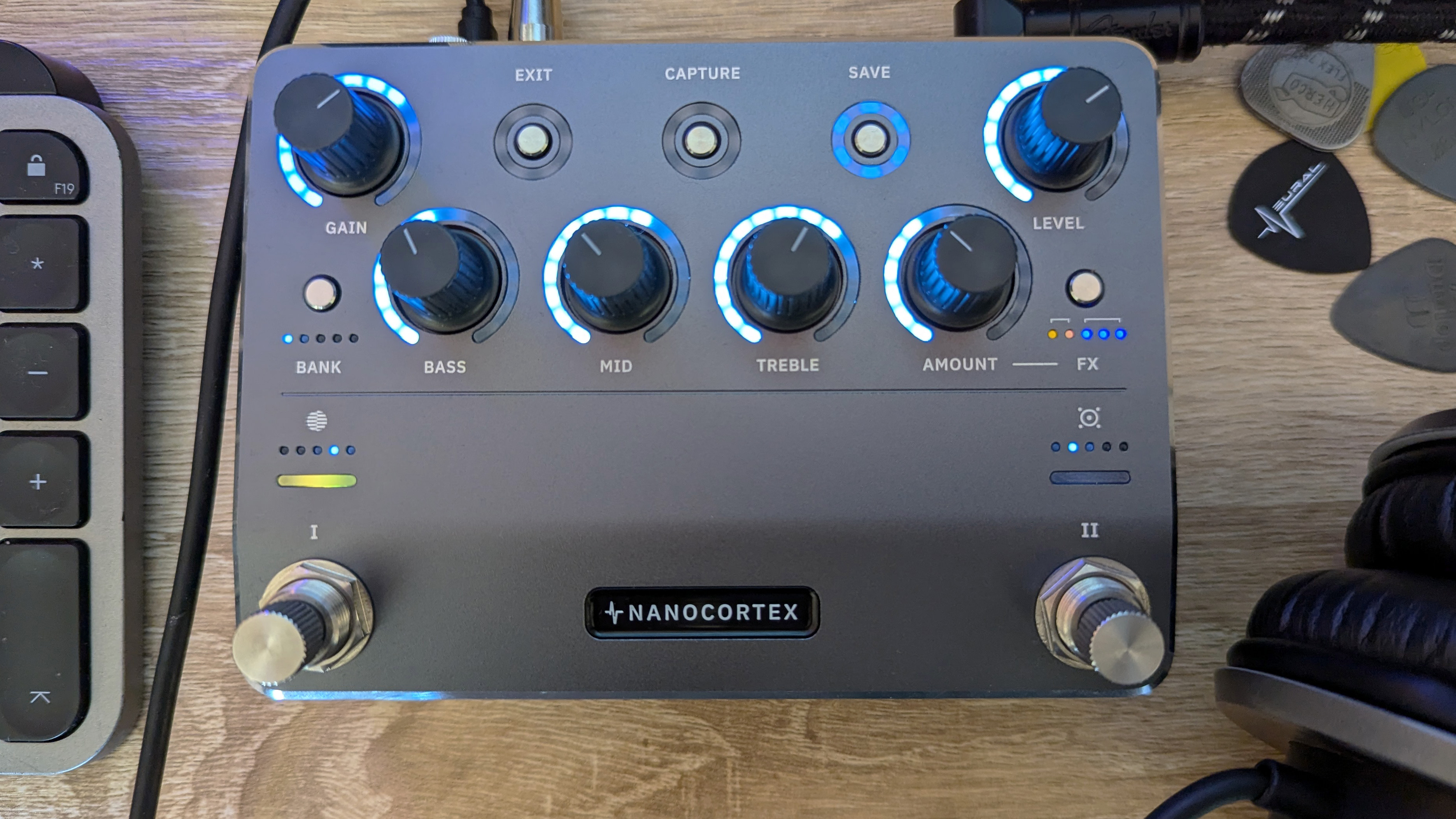
"A model is a full recreation of an amplifier, pedal or any device – it can be a delay or a reverb," he begins. "We can train a full model which is exactly what you see on the real unit. All the knob combinations, all the tone stack combinations, which are not exactly a linear EQ, or just a normal graphic EQ or parametric EQ. Tone stacks of the amps do very weird things, and master volumes as well. Nonlinearities happen everywhere. So we get the exact same thing – all of its features are represented in a model. It will behave exactly the same if you lower the gain, if you increase the gain, lower the bass, treble, mid. You will have exactly the same controls as the real unit that we might be modeling."
A Neural Capture is a snapshot of the current settings that you have on your target device
Francisco Cresp, Neural DSP
A capture is different.
"A Neural Capture is a snapshot of the current settings that you have on your target device," continues Francisco. "So if you want another set of settings, you need to do another capture, and the capture doesn't really allow you to tweak the controls of the 'real' device. We offer you some controls on top, but they are not learned from the source. So that's that's the biggest thing. A model is a full representation of analogue equipment, and the Neural Capture is a snapshot. It's a picture of the configurations that were set at that time."
The kneejerk temptation is to view a capture as lesser compared to a model. But captures allow for a scope of access that is much wider – plenty of Quad Cortex player use captures of their own tube amps live the way they like to set them. Rabea Massaad in Vower, James Moneith in Tesseract and Cage Fight, my mate Chris on the pub scene… just three I've spoken to recently. A capture also opens the floodgates for possibilities for all players to benefit from; there's a whole community of Neural users capturing, uploading and sharing amps, drive pedals and even captures of Neural's own acclaimed plugins. From SLOs to Marshall Plexis, Trainwrecks, Fender Deluxes, Bassmans and yes, Klon Centaurs. This kind of community simply isn't possible with 'models'… yet anyway.
Ok, enough preamble. How does it all add up in the compact dimensions of the Nano Cortex? We better find out.
Features
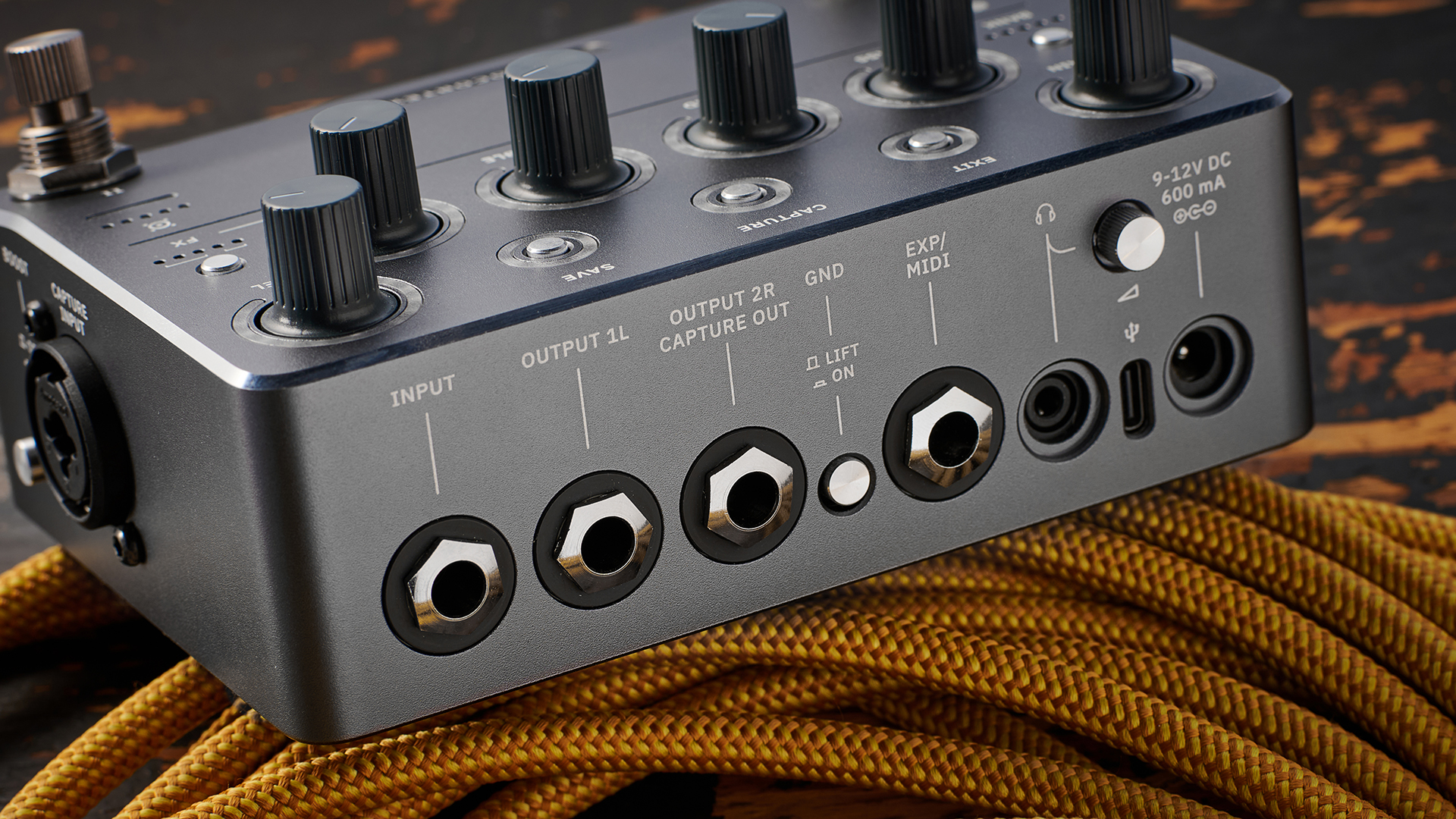
The USB-C power capability is as surprising as it is welcome
The Quad Cortex design DNA is very evident in the shape, LEDs, controls and dark space metal grey chassis of the Nano Cortex that looks like it was created to compliment a MacBook on your desk. It's sleek, it feels solid.
While it can be powered by a 9-12V Dc adaptor requiring 600mA, Neural has also enabled it to be USB-C powered too. This is as surprising as it is welcome; the Nano Cortex can be powered by your laptop, smartphone charger… a power bank. I've tried them all and they all worked. That last option makes this portable, which is an unexpected bonus!
The same USB-C connection can be used for direct recording, and while there is no XLR-out for stage use, which is disappointing but it looks like Neural ran out of space, there is a combo XLR / 1/4" input for capturing. Two outputs, with the second doubling as a capture out (more on that later) enable stereo out, but with no effects loop you'll have to position the Nano Cortex on the pedalboard where you want it in the signal chain in relation to time-based effects like delay pedals. But the Nano Cortex has these effects onboard too – and even more now than at launch with its latest firmware update (see section further on).

Neural has decided to give the option of a self-contained rig solution here to some extent (you can even activate a tuner that uses the LED controls by holding down the second footswitch) and all have been drawn from the Quad Cortex; its own analogue-style delay algorithm, Boss DC2W rack-inspired modulation, a Transpose pitch shifter, the Mind HallRreverb inspired by the classic Alesis 224 and a Neural's Adaptive noise gate. A fine selection that has been chosen for popularity with Quad Cortex users, and Neural isn't ruling out adding to it in the future.
Cortex app

It's a Bluetooth app, but before you run for the hills in preemptive horror, it actually works really well!
There's quite a lot packed into a unit without a screen here. Neural's design swagger comes to the fore in delivering it all in such an intuitive way. Read the manual – it does save time, but I think you'll get to grips with things pretty fast. I admit I'm not a huge fan of screen menus on pedals personally, and the integration of physical hardware controls with the deeper options of the app here proves an agreeable combination for me.
Cortex is a Bluetooth app, but before you run for the hills in preemptive horror, it actually works really well! Well, it certainly did in my testing with Android 14 – the huge variety of phones running different operating systems and versions makes it pretty hard to predict beyond that.
I've been slightly uncomfortable watching the rise in guitar hardware using smartphone apps for full functionality, but Neural proves here what a positive experience it can be. The Nano connected every time with the Cortex app after holding a two-button combination. What really impressed me is how fast it connects and reacts to commands. And once you connect, the full potential of the Nano Cortex reveals itself.

The years of an active community around the Quad Cortex are now clearly pay dividends for the Nano here
You don't need to use the app to enjoy the Nano Cortex out of the box, but if you do you gain access to deeper controls over the effects beyond the Level knob on the hardware (it takes you up or down five semitones for the Transpose pitch shifter). Moreover, you can search the Cortex community for more captures. Prepare to lose hours doing this – it's an Aladdin's cave of goodness with over 34,000 captures available. The years of an active community around the Quad Cortex are now clearly pay dividends for the Nano here.
The tagging on the app for these captures could be better – there's a fair bit of assumed knowledge from the users' naming conventions with some of the amp and cab titles. But you can't really blame Neural for that. Or the inconsistency with the standard of user captures. But before we get to all that it's better to explore the stock selection Neural has already filled the Nano Cortex's 25 slots with – because there's plenty to be enjoyed.
Sounds

You can cycle through the five banks of five guitar and bass amp captures (full list of factory captures below) using the footswitch 1 rotary switch control and a mini button. I'm a huge fan of Neural's rotary footswitch combos and they're the same as the ones on the QC.
Footswitch 2 enables you to select one of five onboard IRs (the additional stock options can be swapped in and out with the Cortex app). Francisco Cresp tells us he consciously organised the captures to go from clean and up to hi-gain and bass, which seems logical. How you choose to organise them when you begin downloading and creating your own captures to replace those slots, is up to you.
Recording with the Nano Cortex on GarageBand via the USB-C connection is the quickest and easiest experience I've ever had tracking guitar sounds
If you've used the Quad Cortex before this next part is not a reveal – Neural's captures are very good indeed. From Princeton to Hi-watt, Bogner, Engl. Mesa/Boogie and AC30, you can dive straight into recording and jamming with these and get highly satisfying results. Recording with the Nano Cortex on GarageBand via the USB-C connection is the quickest and easiest experience I've ever had tracking guitar sounds – and it sounded fantastic, despite my playing!
What you won't get when you start tweaking the gain and EQ controls is the same reactive results as a detailed model. For that kind of authenticity you need to look to the Quad Cortex and its advanced modelling, or some of the other options out there like UA and its standalone UAFX amp pedals filled with the idiosyncracies tube amps can offer.

I found the controls cover enough around the sweet spots the captures here offer – if you're looking to hone in on a detailed deep dive on one amp, this isn't really where you'd look anyway I'd wager. I'm not a tube purist but I could tweak the gain and treble on the '65 Princeton capture here and still feel confident taking it into a band situation. And if it sounds good – it is good.
"The difference of Neural Capture versus other options is that we can learn what is the nonlinear behavior of the device that is being captured," Francisco tells me, though he's bound to secrecy on specifics. "It's more precise in a certain way. I can't disclose too much about the rest, but there is a certain advantage of a Neural Capture versus other competition products."
I felt this was especially accurate with the gain control on the Neural Captures I tried – the scope and feel is impressive.
- Nano Cortex factory capture amps
- BANK 1 (Clean):
- 1. CA John's Ch1 1 (Mesa Boogie® JP2C® Ch1)
- 2. Comet 60 5 (Komet® 60)
- 3. Bogna X100B Ch1 1 (Bogner® Ecstasy 100B® Ch1)
- 4. Watt Custom Clean 7 (Hermansson Hiwatt® Custom PA100® Clean)
- 5. US HRDLX ChA 6 (Fender® Hot Rod Deluxe® Channel A)
- BANK 2 (Edge):
- 1. Comet 60 6 (Komet® 60)
- 2. NoMatch Chief 1 (Matchless® Chieftain®)
- 3. US Prince 65 4 (Fender® Princeton® 65)
- 4. Watt Custom VH 1 (Hermansson Hiwatt® Custom PA100® VH)
- 5. D-Cell H4 Ch2 1 (Diezel® VH4® Ch2)
- BANK 3 (Crunch):
- 1. Bogna Fish+290 5 (Bogner® Fish®) + (Mesa® Boogie® Stereo Simul-Class Ninety)
- 2. Brit 2555 Rhy 12 (Marshall® Silver Jubilee® 2555 Rhythm)
- 3. Custom 3SE+290 2 (Custom Audio Amplifier® 3+SE®) + (Mesa® Boogie® Stereo
- Simul-ClassTM2: Ninet)
- 4. D-Cell H4 Ch3 3 (Diezel® VH4® Ch3)
- 5. ENG Energy 3 (ENGL® Powerball® Mark I)
- BANK 4 (High Gain):
- 1. Bogna X100B Ch3 Lead 18 (Bogner® Ecstasy 100B® Preamp Ch3 Lead)
- 2. CA Studio+290 2 (Mesa® Boogie® Studio Preamp®) + (Mesa® Boogie® Stereo Simul-ClassTM2:Ninety)
- 3. CA John’s Ch3 7 (Mesa Boogie® JP2C® Ch3)
- 4. PV 505Sig 7 (Peavey® 5150® Signature)
- 5. Brit 2555 Lead 1 (Marshall® Silver Jubilee® 2555 Lead)
- BANK 5 (Bass):
- 1. Aggi 751 31 (Aguilar® DB751®)
- 2. Amped SV Classic 3 (Ampeg® SVT Classic®)
- 3. Rodent+SV 3 (ProCo® Rat®) + (Ampeg® SVT Classic®)
- 4. CA MixBass 3 Amp2 (Mesa® Boogie® M6 Carbine®) + (Big Block 750®)
- 5. Anima Fuzz 8 (Human Gear® Animato®)
I've loved trying out dream amps at sensible levels and seeing how they react to my pedals in the way Neural has delivered them here
What's striking is how impressive the stock captures are – from Fender cleans all the way to Diezel and thick Bogner saturation. How harmonically rich and responsive they sound and feel under the fingers – most importantly at lower volumes. I can't crank a real Silver Jubilee at home, even if I was lucky enough to own one, it's not an option, but I've loved trying out dream amps at sensible levels and seeing how they react to my pedals in the way Neural has delivered them here.
It's also great to have all these amps, IRs and cabs on tap to just plug straight into a DAW for recording and get fantastic results, using the onboard reverb and noise gate. It just works.

The combinations possible here are mind-boggling, frankly
Unsuprisingly, there's a sense of the Nano Cortex encouraging you to judge with your ears when it comes to the IRs, which include 4x12 V30 and a 1x10 Princeton. Again, the naming conventions without added descriptions don't make the details of exactly what speakers you're trying clear enough on the app for my liking – especially for newcomers to this world. I found the full list below from the manual.
The good news is for those who want to dig deeper there are five mic choices, five mic positions, plus level controls with high and low pass filters for each. And the option to upload third-party IRs. The combinations possible here are mind-boggling, frankly.
- Nano Cortex factory impulse responses
- 1. 110 US PRN C10R (Fender® Princeton® with Jensen® C10R drivers)
- 2. 112 UK C15 Blue (Vox® AC15® with Celestion® Alnico Blue drivers)
- 3. 115 Amped Modern (Ampeg® SVT® 115HE®)
- 4. 212 Match D30 Sig A (Matchless Amplifiers® DC30® Sig A)
- 5. 212 US TWN C12Q 00s (Fender® Twin Reverb® with Jensen® C12K-2 drivers)
- 6. 412 Brit TV GB75Hz ’69 (Marshall® 1960TV® with Celestion® G12M25 drivers)
- 7. 412 CA Stand OS A V30 ’01 (Mesa® Standard OS Angled with Celestion® Vintage30 drivers)
- 8. 412 CA Trad S UKV30 90s (Mesa® Traditional Straight with Celestion® Vintage 30 drivers)
- 9. 412 Zila Cust V30 ’12 V2 (Zilla® Custom with Celestion® Vintage 30 drivers)
- 10. 810 Amped VT Aln 70s (Ampeg® SVT® 810® with custom Eminence® ceramic drivers)
The result is an appealing mix of deeper app editing with intuitive, streamlined hardware controls. Where things can get hazier is when you begin to download captures that take your fancy via the Cortex app. Search for an amp you've always wanted to try, and there may be multiple options. But the nature of capture means you are lying on the user's ear and ability to mic a guitar cab effectively when it comes to the result.
Many captures I tried sounded great, a few were a fuzzy mess. It's the nature of the community, and it is a great thing on the whole because the quality was largely high and it's easy to move on to the next option. I'd advise ranking captures by popularity first as an indicator of where to start though. Find a hidden gem that's been uploaded? You can share a link to it with a friend. I especially enjoyed the beastly scooped old-school Metallica chug from a Mesa/Boogie MkC+ capture I downloaded.
What I would like to see most is more captures supplied by Neural DSP itself to lead by example beyond the 25 stock options. Perhaps these will come – at the time of writing I found 10 under the company's user profile on the app, but they weren't what I would call obvious choices. Watch this space?
Capturing

Where Neural really pushes the envelope here beyond competition anywhere near the price range is making the Nano Cortex a capture device, one that doesn't even require the app for the process. With a fairly straightforward connection between the source – a mic on an amp cab or a pedal's input and output.
The capturing process takes five minutes max, and you'll then be able to A/B the capture with the source to hear how close it gets. This is not a mini Quad Cortex, but it offers the same quality of capturing and access to captures, and that could make it become your most used piece of gear.
The Nano doesn't have the processing power required to run multiple captures at once like its older brother. So you can't kick in a captured Klon Centaur on one footswitch while running a captured Fender Deluxe simultaneously. But you can capture a model of an amp on its own, then another capture with your favorite overdrive pedal running into that same amp and save those as footswitchable presets. Plus, the April 2025 firmware update detailed below allows a more appealing workaround with the addition of a new overdrive effects section.
Captures available via the app can also offer different channels and settings of amps – clean and overdriven Fenders, for example. Or you might choose to use the Nano Cortex for capturing overdrive pedals alone.
"You can have four booster pedals as presets or combine them," explains Francisco. "You can capture, let's say, a Tube Screamer and SD-1 both on at the same time, and that can be one capture.
"So you can, you can make stacks of things," he adds. "You can capture your Tube Screamer with your SD-1 on and your amplifier on, with the cabinet, with the microphone coming back, and that can be just one capture. So it's really versatile in the sense that you can use it as a pedal platform, it can be your amp, your digital amp, or it can be everything and then you go straight to the front of the house. Or your interface – so there are a lot of use cases for it."

Neural Capture is already a proven technology on the Quad Cortex – it can get very close, obviously bearing in mind you're capturing the target as it is in a specific state. The tech is the same here.
With a real amp there are variables to be considered in the capturing process – some like overloading the level meter are dealbreakers. But that's what the LED monitors are there for and the colour light indicator will let you know when things are running into the red – literally. Other variables like mic placement will take time to experiment with. Pedals are easier to start with as it's just a plug straight in, isolated scenario– I even captured a modelling amp pedal because… well why not!
Usability

Once you hone in on some favourite captures you can assign them to the four preset slots that the footswitches provide – two on each side. Beyond choosing the captured candidates, the challenge I found was tweaking the volume levels between captures.
You're able to set the capture level on the app as well as the level on the Nano hardware so it's a matter of A/B'ing and altering as you go. It's simple to save your latest settings with a button press, and you can also upload from 64 preset slots via the app, half of which are filled with Neural's own presets – some of which could prove very handy for recording, like Bass Classic and Bass Distortion.
It's also worth keeping in mind there are an additional five IRs in the app and the pedal can only host five at a time
It's also worth keeping in mind there are an additional five IRs in the app and the pedal can only host five at a time – so you'll need to use the app to temporarily audition all the options before saving one.
It's a testament to how well the device runs with the app in my testing that this becomes intuitive very quickly. So much so I kept downloading and trying out different options from the array of captures via the Cortex community – it was just so quick and easy to do.
April 2025 2.0 firmware update
When a player invests in modelling and capturing hardware, a huge consideration is how it will be supported and updated by the manufacturer in the future. Neural DSP has already shown a commitment to the Quad Cortex with its ongoing updates that have added enhanced functionality and effects, and now with its first major 2.0 firmware update in April 2025, the Nano Cortex has benefited too.
The additions, including 40 new effects (full list here), are significant enough that I didn't just want to update my original review with a new section dedicated to them, but get insight from co-founders Doug Castro and Francisco Cresp too.
"NanOS 2.0.0 is a major step forward for Nano Cortex," Doug tells me. "What was already a powerful, compact piece of gear is now a complete all-in-one rig. With 47 new effects and utilities, a customisable signal chain, and the new Input Gate, it's now possible to build and control your entire sound without needing any additional gear. You can shape your tone, load up a full rig, and perform virtually anywhere."
Those new effects (including overdrives) are the headline feature here. Alongside the amp captures, it helps to make the Nano Cortex into more of a multi-effects unit than before. The fact you can now combine drives with your captures offers a really useful level of versatility for stage use.
"What’s exciting about this update is the freedom it gives users," adds Doug. "You’re no longer locked into one way of working. Whether you’re using it on its own or as part of a larger setup, everything is more flexible now.
"More than just adding new features, it’s about giving players the tools to do more with less, to be creative anywhere, without compromise. That’s always been the goal with Nano Cortex, and NanOS 2.0.0 brings us much closer to that vision."
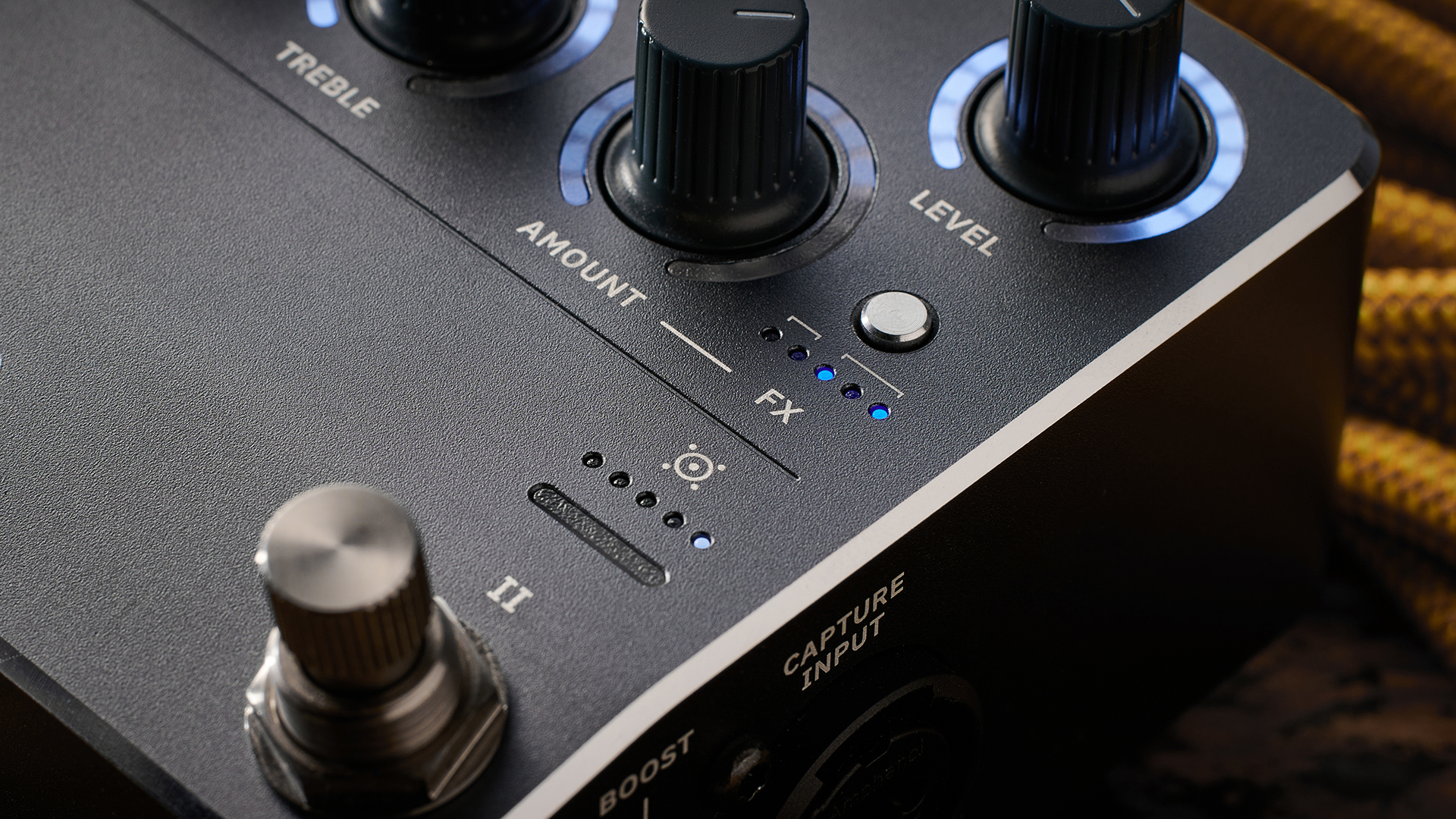
As I try out the new additions, I make a beeline for the overdrives – alongside the DOD 250, there are models of the Fulltone OCD, ProCo Rat, Ibanez TS808, Xotic RC Booster and Dunlop Fuzz Face. All cornerstone pedals, and suddenly I'm making presets with and without drives, and set at different levels – it's solved a missing piece of the Nano Cortex puzzle for me in terms of the usability I want.
"Adding overdrives was certainly a priority," notes Francisco. "It's one of the most requested features, they're essential for so many styles and setups. Being able to switch between different overdrives or between a clean and driven Capture mid-performance gives live players much more control."
Versatility was our guiding principle
Doug Castro, Neural DSP
"That said, our goal wasn’t just about adding drives," adds Doug. "We wanted to introduce a broad range of effects to meet the needs of all players, from high-gain guitarists to clean-focused players and bassists. Versatility was our guiding principle."
That equates to three EQs, four compressors (eight in total with mono and stereo options for each), modulations including the MX Flanger (based off the classic MXR M117R; TC Electronic Dreamscape-inspired Dream Chorus; MX Vibes (inspired by the MXR UniVibe) and a feast of reverb and delay. Room, Hall, Modulated, Ambience and Cave reverbs joined by Tape Delay, Digital Delay, Dual Delay, Circular Delay and Dual Reverse Delay.
A lot to explore, and these models are all impressive, but at the risk of punching a gift horse in the mouth I note there's no Klon-style pedal (a Wampler Tumnus is my go-to drive) or a tremolo here.
"We're careful not to promise future features, but it's definitely possible," Francisco tells me regarding whether we might see them further down the line. "We know those are popular effects, and they already exist in Quad Cortex. Whether or not they make their way into Nano Cortex depends on a number of factors, but it's certainly not off the table."
Good to know, but how did Neural DSP go about selecting the additions that are here?
"We looked closely at what users rely on most with Quad Cortex," says Francisco. "That gave us a solid foundation for selecting effects that are both widely used and musically versatile. From there, we prioritised variety, covering different tonal needs and use cases.
"Our internal team, along with feedback from artists and users, helped refine the list. It was important to not just add devices, but to add the right ones."
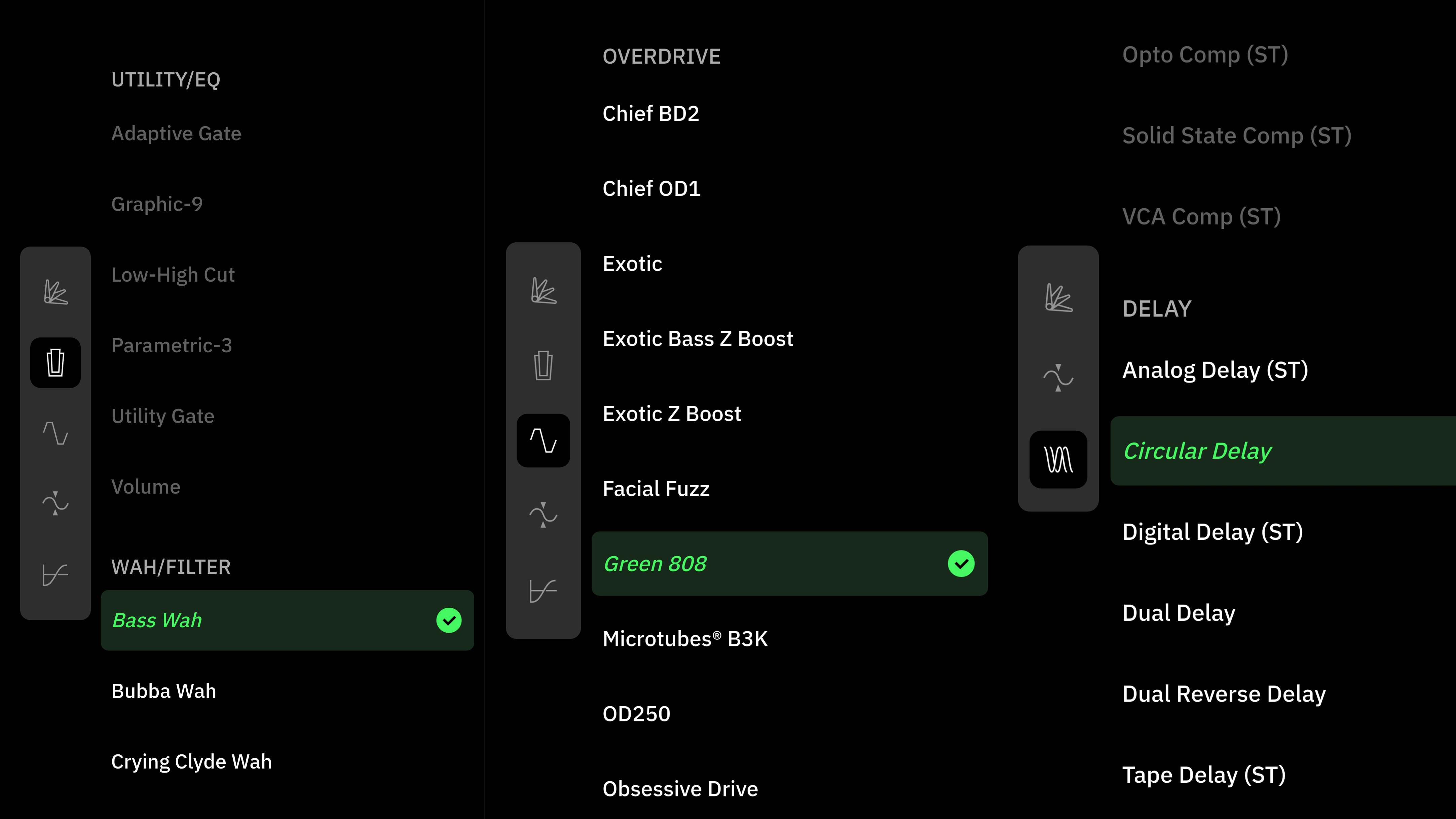
The fixed seven-slot signal chain for the Nano Cortex remains and the amp capture and IR are included in this. There are still two pre-effects slots and three post-effects, but the signal chain is now customisable in terms of order within these… to some degree anyway. The compressors and equalizers are an exception as they can be played in any slot, e.g the end or start of your chain. Overdrives and wahs are in the pre-effects slots while the reverbs, delays and reverbs can be placed in any order but within the post-effect slots.
I think this offers enough flexibility for most players and the huge appeal for everyday use is having presets with variations on your favourite amp captures; four across the two switches could give many players enough to cover a gig or recording session with while retaining a consistent amp and IR foundation sound.
With all the excitement around the headline effects, the new utility effects here shouldn't be overlooked. There are three: Utility Gate, Volume and Doubler.
The Doubler is something I've rapidly become a big fan of
The first two are pre-effects and I found them to be very useful in different ways. Utility Gate shouldn't be confused with the existing Adaptive Gate that adapts to your real-time playing, the Utility Gate allows the player to set the threshold manually. It helps to deal with unwanted noise for high-gain amps, especially.
The Volume control allows an expression pedal to be connected to give you a volume pedal – handy for all kinds of dynamic uses live, from swells to fade out/in. The Doubler is something I've rapidly become a big fan of – think of it as an instant thickener for your tone, and a great tool to kick in as a preset live as well as double-tracking live. Excellent for bulking up those big riff moments!
Nano Cortex is small, but we designed it with plenty of processing headroom to support future growth
Francisco Cresp
While there's plenty here, this isn’t the last Nano Cortex update by any means, and it’s a very significant start. In terms of roadmap moving forwards Neural DSP is keen to take on player feedback, just as it’s done with the flagship Quad Cortex.
“We have a clear development roadmap for Nano Cortex, but community feedback plays a huge role in shaping how we prioritize and refine that roadmap,” Francisco tells me. “Input from users and artists is constantly informing what we build next.
“Just as with Quad Cortex, we’re committed to supporting and evolving the product long after release.”
This inevitably involves overcoming technical challenges on a daily basis – something the Neural team has proved very adept at.
“Nano Cortex is small, but we designed it with plenty of processing headroom to support future growth,” says Francisco. “That said, it’s a different product than Quad Cortex, it has unique strengths and constraints.
We want to push the device as far as it can go
Francisco Cresp
“The biggest challenge is balancing power and simplicity,” he reveals. “We want to push the device as far as it can go, while keeping the experience fast, intuitive, and accessible for all types of players.”
The commitment Neural DSP has to ongoing support underlines that it’s now part of the buying decision for players. We’re not just investing in what the product is now, but what it will be in the future.
“Long-term support is essential, and we take it seriously,” Francisco tells me. “With Quad Cortex, we've shown that we’re committed to meaningful updates, ones that genuinely expand what the product can do.”
“At the same time, we believe it’s important for users to feel satisfied with the device as it is today,” adds Doug. “Firmware updates should feel like a bonus, something that extends your investment rather than a requirement for satisfaction. Our goal is to keep delivering those kinds of updates for as long as we can.”
Verdict

For any one of these use cases alone the Nano Cortex could be worth the money, and if two or more apply to you, it could become an irresistible purchase
The real key to the Nano Cortex is ease of use with flexibility and great sounds; some may never actually use it to capture an amp, but the proposition of being able to travel with it and power from a power bank into headphones will be a draw. Others may never put it on a pedalboard – it will stay as their source of recording tones at home. Someone else will have it as the centre of their live rig – running direct to a PA or an FRFR cab. Others will specifically want to capture their tube amp for a portable rig. For any one of these use cases alone the Nano Cortex could be worth the money, and if two or more apply to you, it could become an irresistible purchase.
The app worked well in my testing, and the 2.0 firmware update has already expanded its functionality. As Neural has proved with the Quad Cortex, it will support long-term with firmware updates that enhance usability and add features. So far, 40 new effects is a great start!
Going with a capture device makes sense in light of the usability and scope of the Cortex community that's already very much active with Quad Cortex users. And the Neural difference aside, while other pedals can load captures, as a capturing device at this price the Nano Cortex finds itself offering something distinct, for now at least.
Captures aren't for everyone – there's plenty of choice out there for great amp modellers and guitar multi-effects units, but the leap to Neural's own device that offers modelling is over $1,000 from here. As a product that opens up access to undeniably great tones and effects in a portable pedal, one that fits into many scenarios and situations, the Nano Cortex is very easy to recommend. This could easily become your new favourite piece of guitar gear.
MusicRadar verdict: The Nano Cortex is the best all-in-one capture device for value, portability and usability right now. The latest 2.0 firmware update has expanded its multi-effects versatility significantly and Neural DSP has opened up its technology to more players here, delivering a versatile and compact pedal capable of delivering great sounds in different scenarios.
Hands-on videos
Neural DSP
Leon Todd
Mark Johnston
Specifications
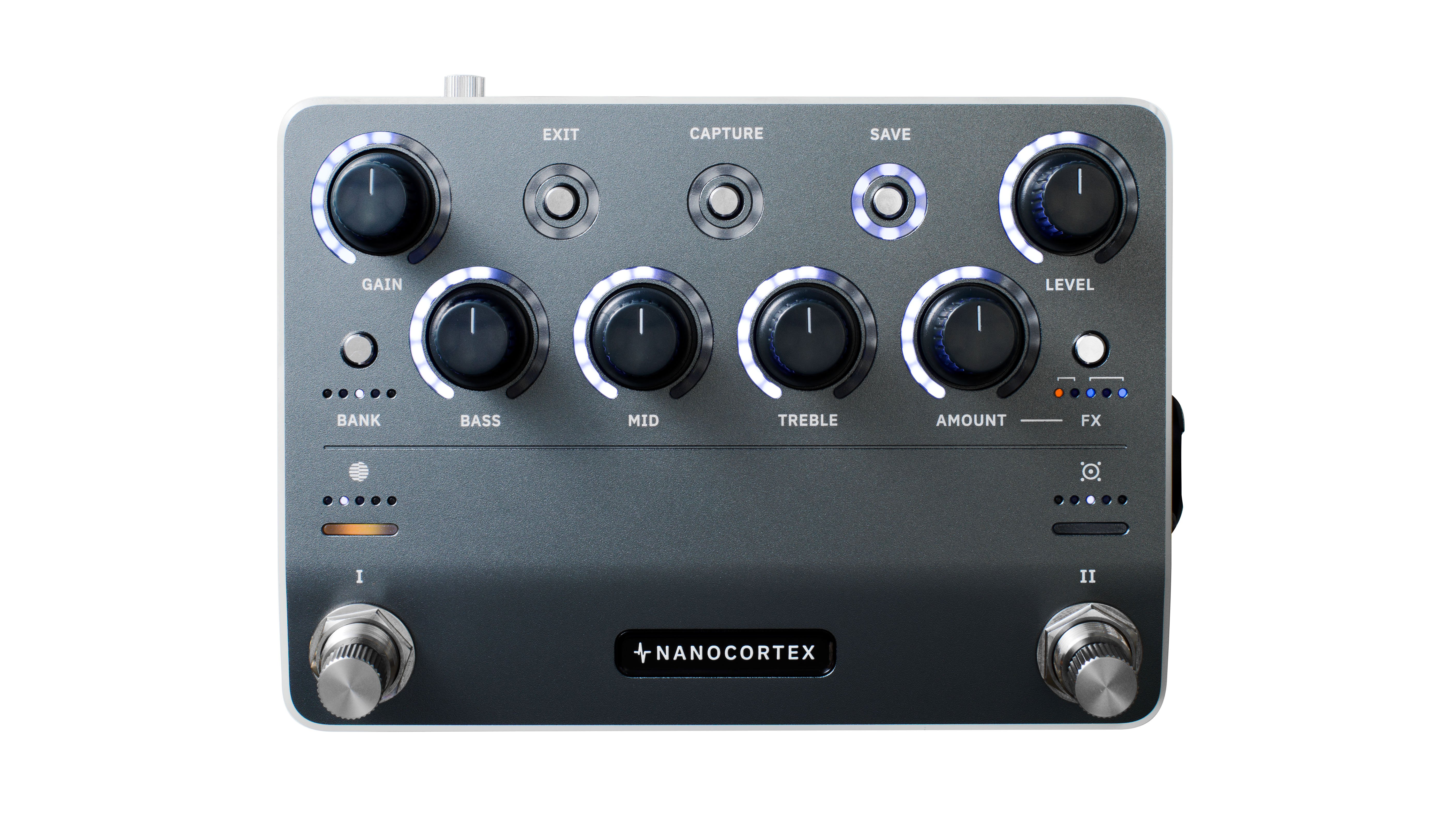
- CONTROLS: Level, Gain, Bass, Mid Treble, capture bank select button, capture / preset select rotary footswitch, FX select button, IR / preset select rotary footswitch, Exit, Capture mode, Save buttons, headphone output volume control, ground lift switch (for outputs 1L and 2R, Boost switch (when enabled boosts the capture input +26dB).
- FEATURES: 24-bit, 48kHZ audio interface, 25 onboard captures, 5 onboard IRs, 45 effects, chromatic tuner, USB-C MIDI out (up to 12 MIDI messages per footswitch preset), expression pedal support, variable LED brightness (via app), global bypass footswitch option (Footswitch II), direct USB recording with dry and processed simultaneous recording, ground lift switch.
- CONNECTIONS: 1/4" jack input, stereo 1/4" outputs 1L and 2R (latter is also capture out), headphone in, 1/4"/XLR capture source input, USB-C power / MIDI / computer connection
- Power: USB-C, 9-12V DC 600mA
- Dimensions: (W x D x H): 14.4cm x 10.3cm x 6.2cm
- WEIGHT: 620g
- CONTACT: Neural DSP

Rob is the Reviews Editor for GuitarWorld.com and MusicRadar guitars, so spends most of his waking hours (and beyond) thinking about and trying the latest gear while making sure our reviews team is giving you thorough and honest tests of it. He's worked for guitar mags and sites as a writer and editor for nearly 20 years but still winces at the thought of restringing anything with a Floyd Rose.
You must confirm your public display name before commenting
Please logout and then login again, you will then be prompted to enter your display name.
